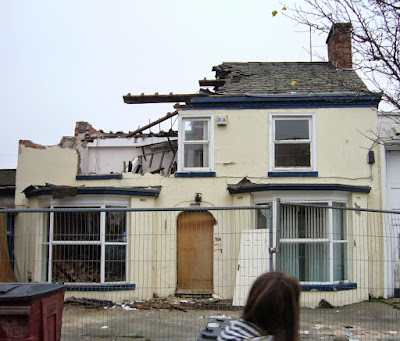I rather think we have become careless with our buildings.
 |
| The Lychgate and Bell Tower, 1978 |
It is a thought prompted by yesterday’s post on the absence of a list of old buildings in Didsbury.*
But it applies equally to Chorlton , and I guess almost everywhere.
We do still have a few examples of buildings dating back to the late 1700s, along with a few more from the early 19th century, and of course there are also Barlow Hall and Hough End Hall.
Although if I wanted to be pedantic, Hough End Hall was actually in Withington, and little that you see either inside or outside is original.
The majority of properties date from no later than the 1860s onwards and many were lost during the last century, these included a slew of fine mansions built for the comfortably off, and a collection of more humble homes dating from the 1820s and 30s, some of which may have been one up one down houses.
In the last decade and a bit we lost two houses on Beech Road which were built when we were still a small rural community, and in both cases we can track the residents back to the early 19th century.
And even the more humble farm houses and labourers cottages have histories which we can discover, even if they have vanished, like Higginbotham’s home on the green or Brownlow’s Cottages on Sandy Lane.
But their existence and their history will be known to the owners and a handful of interested people.
 |
| Beech Road, with Mr. Clarke's smithy, circa 1880 |
Tracking the age of a house is not difficult, even if there are gaps in the historical narrative, and I have done a few, but the list is small.
In the case of Didsbury, I asked a few people, thought about trying the City Council Planning Department and emailed the Didsbury Civic Society, and then fell back on the two well known history books, which offered up a comprehensive list.
Here in Chorlton, we do have a few historians who have referenced old buildings, and of these Thomas Ellwood’s account written in 1886 is still valuable, not least because he offers up details of the homes of the farmers and labourer’s who occupied them in the early 19th century.
 |
| Sutton's Cottage, 1892 |
So that left me with Historic England, which has a database of “The most important historic places in England", including “buildings, battlefields, monuments, parks, gardens and more”, and a visit to the site offered up results.**
But if I have this right, the list is of buildings which have been listed, and that requires someone to make an application, which is matched against the criteria, and a judgement is taken.***
At which point I hear people mumbling “so what? All houses have something about them, and the logic would therefore dictate that every house in Chorlton should be on the list”.
And even if you apply the broad criteria used to consider an application there are problems. So, “to justify special historic interest a building must illustrate important aspects of the nation’s history and / or have closely substantiated historical associations with nationally important individuals, groups or events; and the building itself in its current form will afford a strong connection with the valued aspect of history, which is fine, but what constitutes an “important aspect of the Nation’s history”?***
 |
| Row House, under demolition after two hundred years, 2008 |
A decade ago we might have thought a statute to someone involved in the slave trade was distasteful, but reflected part of our history.
However, the recent continuing revaluation of how we view the slave trade, and who we should single out as worthy of positive recognition has changed.
And in the same way history books, historians and opinion makers have not always seen the importance of recording the contribution made to our collective story by the working class, by women or by ethnic groups.
That list in Historic England includes just six historic Chorlton buildings, so perhaps it’s time to bring more out of the shadows.*****
How of course is another question, but perhaps a database, open to all to contribute, which provides an address, and date, with if possible some more background information.
Who would set it up and how it would be maintained I leave hanging in the air, but it is possible, and would be fun.
 |
| Higginbotham's farm buildings, on the green, circa 1880s |
 |
| St Clement's Church, circa 1880 |
*Making that list of Didsbury’s houses ………, https://chorltonhistory.blogspot.com/2021/03/making-that-list-of-didsburys-houses.html
**Historic England, https://historicengland.org.uk/
***Principles of Selection For Listed Buildings, Department for Digital, Culture, Media and Sport, 2018, https://assets.publishing.service.gov.uk/government/uploads/system/uploads/attachment_data/file/757054/Revised_Principles_of_Selection_2018.pdf
****Chorlton War Memorial, Manchester Road, John Holland’s Wood, a picture, circa 1900-1903, Higginbotham’s Farm, Chorlton Green, The Lychgate and Bell Tower, Chorlton Green, the Former Temperance Billiard Hall, Manchester Road, Barlow Hall, St Clement’s Church, Edge Lane, Hough End Hall, The Lloyds Hotel, Wilbraham Road, Listed Buildings, Chorlton, Historic England, https://historicengland.org.uk/sitesearch?searchType=site&search=chorlton
No comments:
Post a Comment